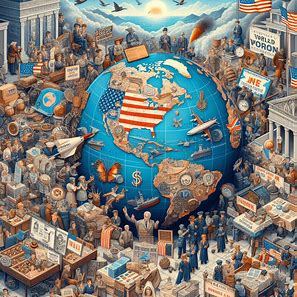Frida Kahlo
Frida Kahlo
Frida Kahlo (1907-1954) was a Mexican artist whose work revolutionized art through her unflinching exploration of identity, gender, class, and postcolonial Mexican culture. Her life and art were profoundly shaped by personal suffering, political conviction, and an unwavering dedication to authenticity.
Early Life and The Accident: Born Magdalena Carmen Frida Kahlo y Calderón in Coyoacán, Mexico City, Kahlo contracted polio at age six, leaving her with a limp. The defining moment of her life came at age 18 when a bus accident left her with severe, lifelong injuries. During her recovery, she began painting self-portraits using a mirror mounted above her bed, marking the beginning of her artistic journey.
Artistic Style and Themes: Kahlo's work is characterized by:
- Self-Portraiture:
- Created 55 self-portraits out of 143 known paintings
- Used her face as a vehicle for expressing physical and emotional pain
- Incorporated Mexican folk art elements and pre-Columbian symbolism
- Combined realism with fantastic elements and surreal juxtapositions
- Mexican Identity:
- Embraced indigenous Mexican culture in her dress and art
- Used vibrant colors characteristic of Mexican folk art
- Incorporated pre-Hispanic symbols and myths
- Celebrated Mexican traditions and natural elements
- Personal Pain and Medical Imagery:
- "The Broken Column" (1944) depicts her spine as a shattered stone column
- "The Two Fridas" (1939) shows her heart torn between two identities
- "Without Hope" (1945) illustrates her forced feeding during illness
- Documented her miscarriages and surgeries through metaphorical imagery
Notable Works:
- "The Two Fridas" (1939):
- Double self-portrait showing her Mexican and European identities
- Connected by exposed hearts and shared arterial connection
- Created during her divorce from Diego Rivera
- One of her largest works
- "Self-Portrait with Thorn Necklace and Hummingbird" (1940):
- Features Kahlo wearing a necklace of thorns that makes her bleed
- Incorporates symbolic elements: dead hummingbird, monkey, cat, butterfly
- Demonstrates her ability to transform pain into powerful imagery
- "The Wounded Deer" (1946):
- Self-portrait as a wounded stag in a forest
- Combines human and animal forms
- Represents her physical and emotional suffering
Political and Social Contributions:
- Gender Politics:
- Challenged traditional gender roles through her art and lifestyle
- Openly addressed female experiences including miscarriage and pain
- Refused to conform to conventional beauty standards
- Embraced her facial hair and unibrow as symbols of defiance
- Political Activism:
- Active member of the Mexican Communist Party
- Promoted indigenous Mexican culture and anti-imperialism
- Supported various revolutionary causes
- Used her art to comment on social and political issues
- Cultural Impact:
- Influenced feminist art movements
- Inspired discussions about disability and chronic pain in art
- Promoted Mexican cultural identity internationally
- Became an icon for Chicana/o and LGBTQ+ movements
Artistic Techniques:
- Color Use:
- Bold, vibrant colors drawn from Mexican folk art
- Symbolic use of color to convey emotional states
- Strong contrasts and dramatic color combinations
- Composition:
- Often centered and symmetrical arrangements
- Detailed backgrounds filled with symbolic elements
- Integration of text and image
- Multiple narrative layers within single works
- Symbolism:
- Personal iconography including monkeys, deer, and hearts
- Pre-Columbian imagery and Mexican folk art elements
- Natural elements like roots, vines, and thorns
- Religious and mystical symbols
Legacy and Influence:
- Art World Impact:
- Pioneered confessional art
- Influenced subsequent generations of artists
- Helped establish Mexico as a center of modern art
- Inspired new approaches to self-portraiture
- Cultural Legacy:
- "Fridamania" phenomenon in popular culture
- Influence on fashion and design
- Symbol of Mexican national identity
- Icon of feminist and disability rights movements
- Contemporary Relevance:
- Continues to inspire discussions about identity and representation
- Work resonates with contemporary social justice movements
- Influence visible in contemporary Latin American art
- Growing academic interest in her artistic innovations
Personal Life and Relationships:
- Marriage to Diego Rivera:
- Tumultuous relationship marked by mutual infidelity
- Collaborative artistic partnership
- Political alignment and shared ideals
- Impact on her artistic development
- Other Relationships:
- Had affairs with both men and women
- Relationship with Leon Trotsky
- Maintained extensive correspondence with cultural figures
- Complex network of artistic and political connections
Technical Achievements:
- Innovation in Medium:
- Experimented with different painting surfaces
- Combined oil paint with other materials
- Developed unique approaches to ex-voto painting style
- Created works on metal and glass
- Documentation:
- Kept detailed journals and sketches
- Photographed her works extensively
- Wrote letters describing her artistic process
- Left behind comprehensive records of her technique
Frida Kahlo's work continues to resonate because it speaks to universal themes of pain, identity, and resilience while remaining deeply personal and culturally specific. Her ability to transform personal suffering into powerful artistic statements, combined with her political consciousness and cultural pride, makes her a uniquely influential figure in 20th-century art. Her legacy extends far beyond the art world, influencing discussions about gender, disability, postcolonial identity, and the role of art in social change.




Comments
Post a Comment